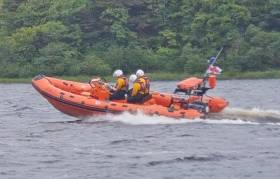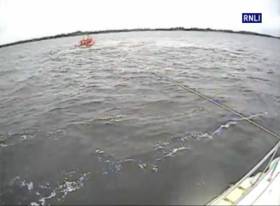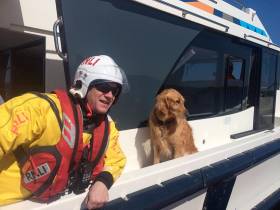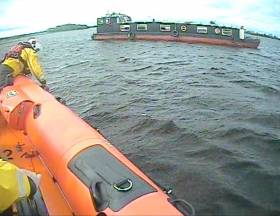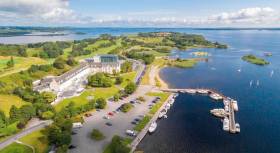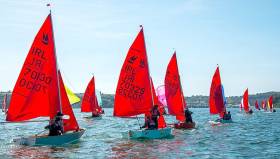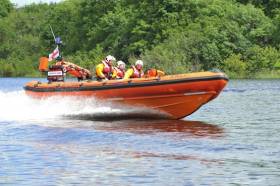Displaying items by tag: Lough Ree
Lough Ree Lifeboat Responds To Island Medical Emergency
#RNLI - The volunteer crew of Lough Ree RNLI were alerted by the Irish Coast Guard yesterday afternoon (Saturday 3 June) to attend a medical emergency on an island in Lough Ree.
The alarm was raised shortly after 1pm on behalf of an island resident suspected to have suffered a stroke.
Volunteer launch authority Billy Henshaw got Lough Ree lifeboat The Eric Rowse launched and underway within nine minutes. The lifeboat, helmed by volunteer Tom Bradbury, reached the island less than 15 minutes later.
Conditions at the time were mostly dry with occasional heavy showers of rain and a strong south-westerly Force 5 wind with a moderate swell on the lake.
Upon reaching the island, the lifeboat crew assessed the casualty’s condition as not immediately life-threatening, but prepared to administer emergency aid should the casualty’s condition deteriorate.
The crew continued to monitor the casualty until the medevac helicopter Rescue 112 landed on the island a short time later.
The lifeboat crew transferred the casualty to the care of the paramedics, and remained on scene to assist with moving the casualty to the helicopter for airlift to hospital for further assessment and treatment.
Speaking after the callout, Lough Ree RNLI lifeboat press officer Sarah Groarke said: “Our volunteer crew members are trained to assess and monitor casualties and to administer emergency care, such as CPR and oxygen, if necessary.
“We were happy to assist the Rescue 112 paramedics in this case and hope that the casualty will make a full recovery.”
#RNLI - Lough Ree RNLI’s lifeboat crew were alerted by the Irish Coast Guard to two separate incidents on Saturday 27 May.
The first alarm was raised at 11.04am when two people on board a 32ft motor cruiser ran aground north-west of Inchbofin Island, near the eastern shore of the lake.
Lifeboat operations manager Tony McCarth, assisted by shore crew Bernard Larkin and Denis Begley, had Lough Ree lifeboat The Eric Rowse launched and underway in less than 15 minutes with crew members Stan Bradbury, Kieran Scullion and Stewart McMickan on board.
Weather conditions at the time were difficult, with heavy rain and a strong Force 4 breeze from the north-west. Visibility was poor and there was a moderate swell on the lake.
The Eric Rowse was alongside the casualty vessel at 11.31am, with the lifeboat crew checking that all on board were uninjured and wearing life jackets. Once established that the vessel was not taking on water, the lifeboat towed it off the sandy shoal to safe navigable water.
All equipment on the boat was confirmed to be in good working order, and the people on board were able to continue their journey to Lanesboro at the north end of Lough Ree.
The lifeboat crew returned to station at Coosan Point, where the shore crew prepared The Eric Rowse for service once again by 12.30pm.
Less than three hours later, 3.15pm, the volunteers were alerted again – this time to assist eight people aboard a hire cruiser aground north of the Black Islands, at the north-east shore of Lough Ree.
Launch authority Billy Henshaw and shore crew member Bernie Larkin launched the lifeboat at 3.26pm, crewed again by volunteers Bradbury, Scullion and McMickan.
The lifeboat crew reached the cruiser at 3.49pm and proceeded to conduct the usual checks before towing the cruiser to safety. The eight people on board then continued their journey south to Athlone, and the lifeboat crew returned to the station, where The Eric Rowse was reported ready for service again at 4.50pm.
Speaking later on the day, Tony McCarth said: “We were happy to be able to assist in both callouts today and to help these 10 people continue to enjoy their weekend on Lough Ree.
“Heavy rain leads to poor visibility on the lake, which can make locating navigation markers difficult, even in calm conditions. We remind all users of the lake to ensure they check the weather forecast and seek local advice on likely conditions on the lake before leaving harbour.”
#RNLI - Lough Ree RNLI’s lifeboat crew were alerted by the Irish Coast Guard on Monday morning (8 May) when four people and their dog on board a 40ft motor cruiser ran aground on the Long Shoal near the eastern shore of Lough Ree.
The alarm was raised just after 10.30am and shore crew Tony Diskin, Matt Harte, Billy Henshaw and Denis Buckley responded quickly, reading The Eric Rowse for launch in less than 15 minutes with first responders Denis Begley, Stan Bradbury and Emmet Devereaux on board.
A short time later, the lifeboat crew was alongside the casualty vessel, checking that all on board were uninjured and wearing lifejackets.
Weather conditions the time were dry and sunny, with a Force 3 easterly breeze and a slight swell on the lake.
After checking that the motor cruiser was not taking on water, a tow line was established and the vessel was safely towed to deeper navigable water, from where its proceeded under its own power north towards Lanesboro.
Speaking after the callout, Lough Ree RNLI volunteer Denis Begley reminded cruisers on Lough Ree and other inland navigations to consult their charts regularly for rocky places like the Long Shoal in otherwise deep navigable areas.
#RNLI - Lough Ree RNLI’s lifeboat crew were alerted by the Irish Coast Guard yesterday morning (Saturday 29 April) when a 56ft barge with three people on board ran hard aground on rocks close to Blackwood Point, at the northern end of Lough Ree.
Shore crew Tony Diskin, Matt Harte, Billy Henshaw and Dennis Buckley responded quickly when the alarm was raised shortly before 10 am and got the inshore lifeboat The Eric Rouse launched and underway in less than ten minutes, with first responders Kieron Sloyan, Kieran Scullion and Liam Sherringham on board.
A short time later, the lifeboat crew was alongside the casualty vessel, checking that all on board were safe and well. Weather conditions at the time were dry, with strong Force 5-6 wind and a rising swell with waves up to a metre high.
After checking that the vessel was not taking on water, a tow line was established and the vessel was safely towed to deeper navigable water.
Crew member Kieran Scullion remained aboard the barge to check that all systems were operating normally and to assist with navigation on the journey north to Lanesborough Quay, accompanied by the lifeboat. Upon arrival at Lanesborough, the crew ensured that the barge was securely berthed before departing the scene.
On return to the lifeboat station, the crew observed a hire vessel straying outside the navigation channel between Clawinch Island and Quaker Island.
The crew diverted course to the hire vessel and guided the occupants back to safe water. A lifeboat crew member was invited on board the vessel and spent some time assisting the hire vessel crew in identifying the navigable areas of the lake.
The lifeboat crew also advised the occupants of the difficult conditions further south, whereupon the hire vessel decided to return north to Ballyleague Harbour until conditions for crossing the lake improved.
Speaking following the callout, Lough Ree RNLI lifeboat operations manager Tony McCarth said: “It was a busy day for the lifeboat on Lough Ree and we were delighted to be able to assist.
“As we continue to enjoy this Bank Holiday weekend and as we look forward to the main boating season starting, we would like to remind everyone planning a trip on the lake to respect the water.”
Kayaker Dies After Lough Ree Incident
#LoughRee - RTÉ News reports that a man has died after an incident while kayaking on Lough Ree yesterday afternoon (Saturday 4 March).
Coastguard and RNLI teams recovered the casualty, believed to be an experienced water sportsman, after he went missing between Hodson Bay and the village of Lecarrow. He later died at Portiuncula Hospital in Ballinasloe.
Speakers Announced For Dive Ireland 2017
#Diving - A number of main stage speakers have been announced for Dive Ireland 2017 at Athlone’s Hodson Bay Hotel from 4-5 March.
Marine salvage specialist Brian McAllister will talk the challenges of raising the Costa Concordia off the coast of Italy, a pioneering effort that involved the greatest minds and hands in the industry.
Renowned wreck diver Barry McGill discusses the struggle to control pivotal shipping waters in the North Atlantic off the Irish coast during the First World War by the use of U-boats and mines.
On a similar war theme, Irish-born but France-based diver and photographer Catherine Connors surveys the remains of the Second World War’s Operation Overlord, better known at the D-Day landings.
Closer to home, Tosh Lavery gives a brief history of the Garda Underwater Unit and its work on missing person and murder cases alike.
The Dive Ireland International Expo is the event of the year for all underwater enthusiasts, featuring two days of talks, trading and networking on Lough Ree that also includes the AGM of the Irish Underwater Council (CFT) on Sunday 5 March.
More details are available from DiveIreland.ie
New Skills On Offer As Mirror Dinghy Training Set For Lough Ree
The Irish Mirror sailing season starts in less than two weeks with the first weekend of the Winter Training Programme. The winter training is held, as in previous years in Lough Ree YC, and is run over four weekend sessions between January to April. The quality of the training is only ever as good as the quality of the coaches and with Graeme Grant and Scott Flanagan the class says its 'very fortunate to have an outstanding team'.
This year’s World Championships are been held in nearby Cornwall. A good number of our sailors have already indicated that they plan to take part. We aim to use our winter training program to give them the best possible preparation. However, the winter training is aimed at all sailors, to help them improve as sailors and to get the most out of their boats. This is as relevant for club racing and the regional events as it is for the World Championships.
Most double handed dinghy sailing fleets have had a difficult time attracting numbers in recent years. The extra complexity of the rigging of a boat flying two extra sails as well as problem of finding and working with another crew member appears to put many off. These problems should be viewed against the learning of new skills that are as relevant in a dinghy as they are in a yacht, and the fun had when shared with another sailor.
The cost isn’t even particularly prohibitive when it comes to Mirrors. It’s possible to get a well cared for ten year old boat and be very competitive, even win, says Gail McAllister of the class association.
Seven Callouts In Five Days For Lough Ree Lifeboat
#RNLI - Lough Ree RNLI's volunteer lifeboat crew had one of their busiest periods ever in the last week, receiving a total of seven callouts over five days to assist people on and around Lough Ree.
The first callout came from the Irish Coast Guard shortly 2pm on Tuesday afternoon (16 August) to reports of a 35ft steel cruiser, with six onboard, aground between Athlone Lock and Clonmacnoise.
Later that afternoon, the crew was again called to assist a man aboard a 25ft sailing yacht aground near Barley Harbour on Lough Ree.
In both cases, the recovery was straightforward and no injury to crew or damage to vessels was incurred.
On Saturday (20 August), the lifeboat crew received three calls to assist vessels in difficulty amid very wet conditions with strong winds.
The first call came shortly before noon to assist three people on board a 33ft motor cruiser that had run aground at Bantry Bay on Lough Ree.
Shortly after 3pm, the lifeboat was again called to assist two people who had rowed a lake boat from Gailey Bay campsite to Quaker Island, but were then unable to row off the island due to the strong onshore breeze.
This was a particularly difficult recovery for the lifeboat crew. After trying several methods to tow the lake boat from the shore, a crew member was put ashore in the difficult conditions to push the lake boat off the shore while the lifeboat at anchor, pulled the tow line.
Eventually, the lake boat and its crew were recovered and the two casualties were brought on board the lifeboat, where they were given life jackets and wrapped in a blanket for warmth.
The lifeboat departed the scene with the lake boat on tow shortly after 5pm and proceeded towards Portrunny, the nearest harbour, where the boat and its rowers were delivered safely ashore.
Also on Saturday afternoon, the coastguard received a call for assistance from a motor cruiser with gear box failure south of Athlone Lock.
As the lifeboat was underway to Quaker Island at the time, Athlone Sub-Aqua Club in Athlone town were requested to assist the motor cruiser south of the lock.
On Sunday evening (21 August), the lifeboat was again requested by the coastguard, this time to assist a boat aground on Lough Ree.
The weather was significantly calmer than on Saturday and the recovery went smoothly, with no damage to the grounded vessel and no injury to its crew.
Commenting on Sunday evening, Lough Ree RNLI lifeboat operations manager Damien Delaney said,
"Our volunteer lifeboat crew have had a very busy few days," said Lough Ree RNLI lifeboat operations manager Damien Delaney after the Sunday evening callout. "We would urge everyone using Lough Ree to ensure they are familiar with the area and to take heed of any weather warnings issued by Met Éireann.
"Grounded vessels are not unusual but with any callout there are a number of factors that should be considered such as the wind direction, the weather conditions and the ability of crew and vessel to navigate these.
"It’s always a good idea for visitors to seek local advice before embarking on a journey on the lake, and to notify someone ashore of the intended departure time, destination and expected return time.
"Make sure you have a suitable means of calling for help and that you have the proper clothing and a lifejacket. You never know when you will need to call for help."
J/24 Westerns Title Goes To Howth Yacht Club
#J24 - Team Ireland's Eye Kilcullen brought the J/24 Westerns title to Howth Yacht Club this weekend in the event's first running since 2014.
Three Howth K25 teams took to the waters at Lough Ree on Saturday (6 August), where Team Ireland's Eye Kilkullen led after four races.
Johnny Bravo also scored two thirds and a fourth to place them well for fourth overall on conclusion of racing yesterday (Sunday 7 August).
Open Day At Lough Ree RNLI Next Saturday
#RNLI - Lough Ree RNLI is holding an open day at the lifeboat station at Coosan Point next Saturday 11 June from 12 noon to 4pm.
All are welcome on the day to meet the crew, tour the station, see the lifeboat and join in the fun with face painting, colouring, games, goodies and lots more.
The Lough Ree crew's most recent callout was on Wednesday 25 May, when they assisted eight people on a 48ft motor cruiser that ran aground on a shoal north of Inch Turk.
With no one in any immediate danger and no sign of damage to the boat, the lifeboat crew set up a towline and moved the vessel into safe water, where the engine was started and the steering was checked for damage.
Under their own power, the group of holiday-makers then proceeded towards Hodson Bay. Weather conditions at the time were described as bright with a northerly Force 2 gentle breeze and calm waters.
Speaking following the callout, Lough Ree RNLI lifeboat operations manager Damien Delaney said: "Our lifeboat crew responded swiftly and were happy to assist and bring the vessel into safe water."





























